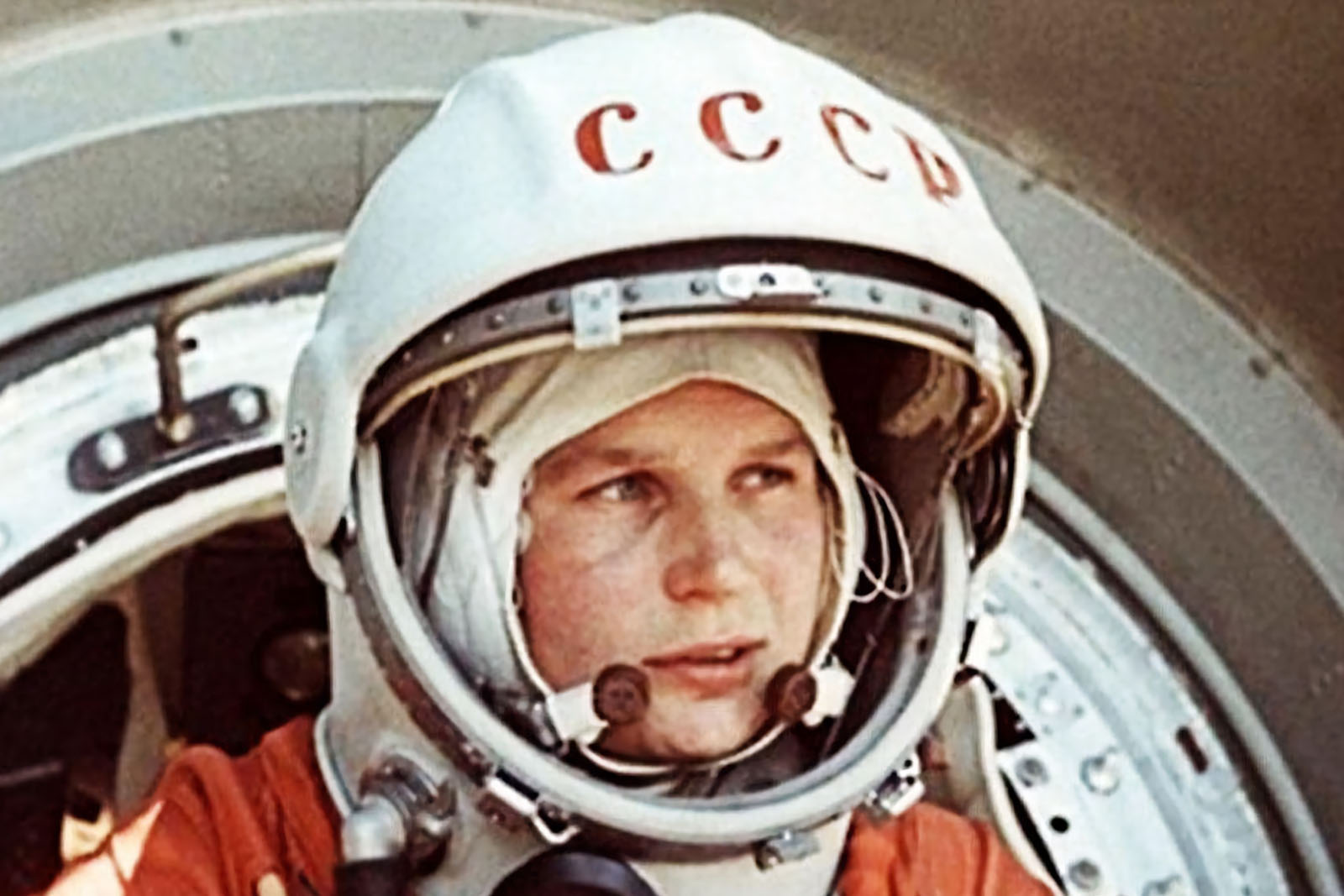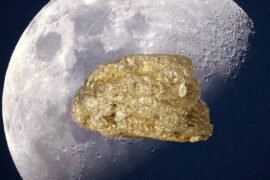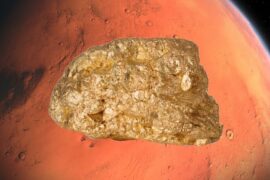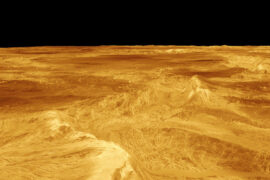What names come to your mind when you think of famous astronauts? Neil Armstrong, Buzz Aldrin or Jim Lovell might come to mind. But none of these brave men was the first person to travel to outer space to become the first official astronaut in the planet. In fact, the one to get that honor was a Russian cosmonaut.
Yuri Gagarin became the first astronaut when he journeyed into outer space aboard the Vostok 1 capsule on April 12th, 1961. The ship completed one lap around our planet, also making him the first human to orbit Earth.
What is an astronaut?
To make sure our answer to the question of the first astronaut is correct, let’s take a look at the official definition of an astronaut.
The Fédération aéronautique internationale (Aeronautic International Federation) defines an astronaut as the person trained for human spaceflight who have participated in flights above 100 kilometers (62 miles).
The United States agencies have a similar line. They award the Astronaut Wings medal for flights above 50 miles (80 km).
Is a cosmonaut the same as an astronaut?
Sometimes you will hear Yuri Gagarin referred to as a cosmonaut. The term comes from the Russian kosmonavt, meaning “a space traveler”.
A cosmonaut is, in essence, the same thing as an astronaut. The only difference is a cosmonaut is only employed by the Russian Space Agency or by the now extinct Soviet space program. So when you hear the word cosmonaut, it simply means a Russian astronaut.
Quick Facts
| Full name | Yuri Alekseyevich Gagarin |
| Date of Birth | March 9, 1934 |
| Parents | Alexey Ivanovich Gagarin Anna Timofeyevna Gagarina |
| Place of Birth | Klushino, Smolensk Oblast, USSR (Russia) |
| Occupation | Pilot, Astronaut |
| Height | 1.57m (5’2”) |
| Nationality | Soviet |
| Missions | Vostok 1 |
| Time in space | 1 hour 48 minutes |
| Died | March 27, 1968 |
| Military rank | Colonel |
| Spouse | Valentina Goryacheva |
| Children | Yelena Yurievna Gagarina Galina Yurievna Gagarina |
| Hobbies | Ice hockey (goalkeeper), Basketball |
Yuri Gagarin Biography
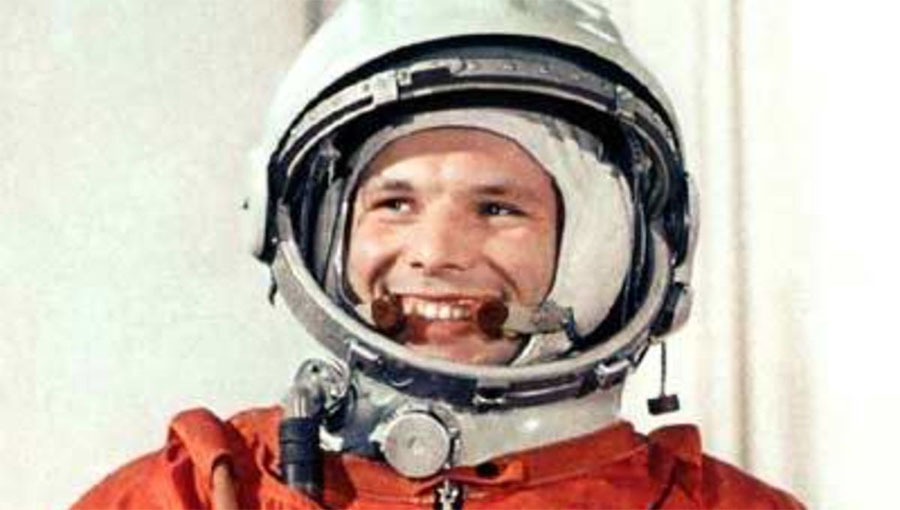
“Orbiting Earth in the spaceship, I saw how beautiful our planet is. People, let us preserve and increase this beauty, not destroy it!”
Yuri Gagarin
Yuri Gagarin was born in the Soviet Union (now Russia) in a small village named Klushino, near what is now Russia’s border with Belarus.
His parents, Alexey Ivanovich Gagarin and Anna Timofeyevna Gagarina worked as a carpenter and dairy farmer on a communal farm. He had one older brother, Valentin, and one older sister, Zoya, as well as a younger brother named Boris.
The Gagarin family went through many hardships during the Nazi occupation of Russia in the second World War. His siblings, Valentin and Zoya were deported for slave labor and the rest of them had to spent almost two years living in a mud hut. After the war, the family moved to the town of Gzhatsk.
In 1951, at the age of 17, Yuri was selected to go to the city of Saratov to enroll at the Industrial Technical School. It was during his time there he began training as a pilot on the weekends at a local flying club.
Thanks to this training, he was later accepted at the 1st Chkalovsky Higher Air Force Pilots School where after a couple more years of training he was finally named lieutenant in the Soviet Air Force in 1957.
It was during this time Yuri met his future wife, Valentina Goryacheva who worked as a medical technician. They married only a few months later in November 1957. The couple had two daughters, Yelena (1959) and Galina (1961).
In 1959. The Soviets launched the Luna 3, an unmanned spacecraft with the mission to photograph the dark side of the moon. This woke up an interest in Yuri for space exploration and he asked to be recommended for the Soviet space program where he was accepted just a few months later along with other 19 candidates.
After some more training, Gagarin became one of the best candidates in the program and was selected for a filter group of six people from which the final crew for the Volstok I mission would be chosen.
The whole project evolved really fast as there was a race between the Vostok program and the U.S. Project Mercury to become the first nation to put a man into space.
After multiple tests, training, and competition between the six candidates, the lieutenant-general Nikolai Kamanin selected Yuri Gagarin as the primary pilot for the mission with German Titov as his backup.
On April 12th, 1961, the Vostok 1 finally launched from Kazakhstan, where to this day the missions to the International Space Station are launched thanks to the country’s favorable conditions. Yuri Gagarin was aboard the spacecraft and with the words “Off we go! Goodbye, until we meet soon, dear friends” he became the first man to achieve the dream mankind has had from ancient times of going to outer space.
The whole mission lasted 1 hour and 48 minutes. After his return to Earth, Yuri became a national hero for the Soviet Union and a celebrity around the world. Parades were thrown for him in Moscow, Warsaw, and other big cities. Gagarin went to more than 30 countries during this little world tour, but due to the tensions between both nations, he never visited the United States.
In 1963 he was awarded the rank of Colonel and became Deputy Training Director of the Star City Cosmonaut Training base, now renamed to Yuri Gagarin Cosmonaut Training Center.
Despite objections from Nikolai Kamanin, the man who originally selected him for the program and overseer for the space program, Gagarin continued to train as a pilot and became the backup pilot for the Soyuz program. Kamanin was worried about losing a national hero to a training accident and the Soyuz program being rushed due to the race with the United States. He was proven right when unfortunately the Soyuz crashed and
Due to this accident, Yuri was banned from training for any further space mission, but he decided to keep on flying planes. Unfortunately, that also turned to have its dangers as only a year later, on March 27th, 1968, Yuri died during a training flight when his MiG-15UTI crashed. His co-pilot, Vladimir Sergoyin also lost his life in the accident. Yuri Gagarin was only 34 years old at the time.
In 1968, the town of Gzhatsk was renamed to Gagarin after him.
Achievements and Awards
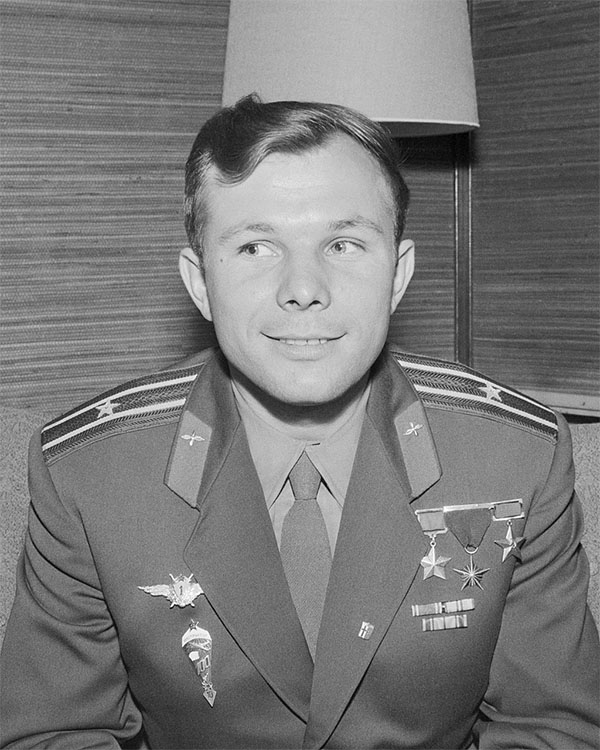
- On April 12, 1961, Yuri Gagarin became the first astronaut to travel to outer space.
- On April 14, 1961, he received the Order of Lenin and Hero of the Soviet Union awards.
- On April 15, 1961, the Soviet Academy of Sciences gave him the Konstantin Tsiolkovsky Gold Medal
- The Fédération Aéronautique Internationale awarded him the De la Vaulx Medal
- He received the Gold Medal by the British Interplanetary Society
- On 1963, he and Valentina Tereshkova (the first woman in space) were awarded the Order of Karl Marx by the German Democratic Republic
- Yuri was awarded multiple other medals and awards in countries such as Poland, Hungary, Italy, and Indonesia.
- As part of the Apollo 11 mission to the Moon, Neil Armstrong and Buzz Aldrin left a memorial satchel on the Moon’s surface as a tribute to Gagarin and Vladimir Komarov.
- To this day, in Russia and the other countries of the former USSR, the 12th of April is celebrated as Cosmonautics Day in honor of the Vostok 1 flight.
- On the 20th and 30th anniversaries of the launch, the Soviet Union issued commemorative coins with his face on them.
- A 140 feet high monument was built in Leninsky Avenue, in the middle of Moscow.
- Many other statues, monuments and streets remembering him have been built or named after him in countries such as the UK, Kazakhstan, Ukraine, Cyprus, and the U.S.
Quotes
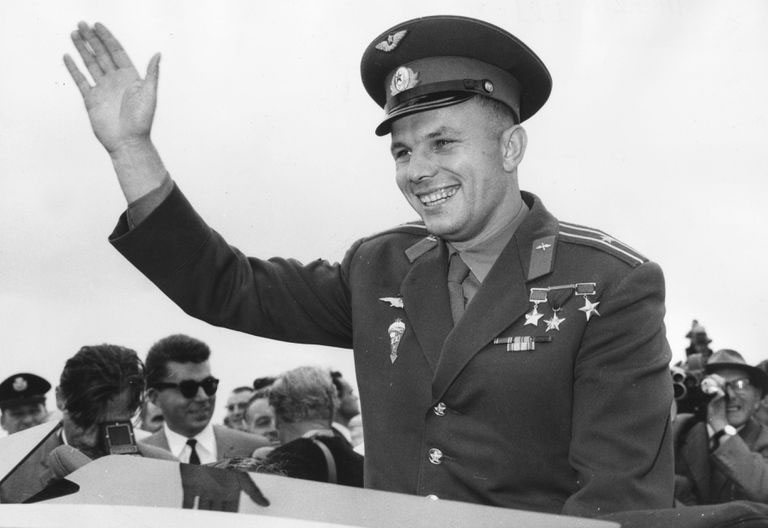
Yuri Gagarin had a way with words. He really managed to convey emotions and feelings when he talked about what it meant to him to travel beyond Earth. He left us some great quotes originally spoken in Russian, so the ones below are hopefully close translations.
“Rays were blazing through the atmosphere of the earth, the horizon became bright orange, gradually passing into all the colors of the rainbow: from light blue to dark blue, to violet and then to black. What an indescribable gamut of colors! Just like the paintings of the Nicholas Roerich”
“The main force in man is the power of the spirit.”
“When they saw me in my space suit and the parachute dragging alongside as I walked, they started to back away in fear. I told them, don’t be afraid, I am a Soviet like you, who has descended from space and I must find a telephone to call Moscow!”
“What beauty. I saw clouds and their light shadows on the distant dear earth. The water looked like darkish, slightly gleaming spots. When I watched the horizon, I saw the abrupt, contrasting transition from the earth’s light-colored surface to the absolutely black sky. I enjoyed the rich color spectrum of the earth. It is surrounded by a light blue aureole that gradually darkens, becoming turquoise, dark blue, violet, and finally coal black.”
A quote that is often attributed to Yuri is “I looked and looked but I didn’t see God” talking about his time up in space. However, there is no evidence he ever actually said this. It is possible the quote was misattributed after a speech by a different person who said “Gagarin flew into space, but didn’t see any god there.”
Trivia
- The town of Gzhatsk, where Yuri’s family moved after WWII was renamed to Gagarin after his death in 1968
- The phrase Gagarin used when his spacecraft launched, “Poyehali!”, meaning something along the lines of “Let’s go!” became so popular, people in the USSR started using it as a greeting.
- He was only 27 years old when the mission took place. To this day, this still makes him the fourth youngest person to travel to space. The three people younger than him are also Russian cosmonauts and only by one or two years.
- Vostok, the name of the capsule that Gagarin orbited Earth on, is Russian for “East”.
- The Vostok spacecraft was controlled from Earth using radio transmissions and the astronaut had no control over it while he orbited Earth. However, he was given a sealed envelope with a key he could use to switch to manual controls in case of an emergency.
- At the time of the spaceflight, there was a bit of a controversy about whether or not the Vostok 1 mission counted as the first manned flight to space. The rules of the Aeronautic International Federation stated that the astronaut had to land back on Earth aboard the ship, but in the Vostok mission, Yuri parachuted out of the capsule and landed alone.
- According to some sources, one of the reasons why he never visited the U.S. was because President John F. Kennedy banned him from entering the country. I’m sure the Soviets didn’t want him visiting either due to the tensions during the Cold War.
- One of the reasons that might have helped him be picked for the mission was his height. He was only 5’2” (1.57m) which helped him not only fit in the capsule better but weight less than other candidates. When it comes to space travel, every pound saved matters.
- Gagarin only beat the U.S. to space by 3 weeks. Astronaut Alan Shepard became the first American man to travel to outer space on May 5, 1961, aboard the Freedom 7.
The Lost Cosmonauts conspiracy. Was Yuri Gagarin really the first man in space?
A popular conspiracy theory alleges the Soviets tried and succeeded in sending at least two other cosmonauts into space before Yuri Gagarin. According to this conspiracy, the flights occurred as soon as 1959 and would have ended up in accidents during the trip back to Earth that resulted in the pilot’s death. The Soviets would have seen this as a failure and therefore covered the existence of these flights.
The supposed evidence for this conspiracy is based on the recording of intercepted radio transmission by two Italian radio operators, an alleged leak by a Czech official and an article by sci-fi author Robert Heinlein who said he was in the USSR at the time and was told by a cadet they had launched a man into orbit that day.
Some of the names of these supposed lost cosmonauts are Vladimir Ilyushin, Alexei Ledovsky, Andrei Mitkov, and Maria Gromova.
The theory has never been confirmed even though after the fall of the Soviet Union a lot of documents from that time were de-classified and made publicly available.
Where to learn more
There are multiple resources where you can delve deeper into the life and work of Yuri Gagarin. Here are a few of our favorite ones.
The book Starman: The Truth Behind the Legend of Yuri Gagarin (Amazon) is a biography written by Piers Bizony and famous documentary maker end Emmy award winner Jamie Doran. It narrates the story of Yuri’s life intertwined with the motivations of the U.S. And Soviet space programs. Interesting read of medium length.
Gagarin himself wrote an autobiography titled Road To The Stars (Amazon). I don’t personally know any Russian, but those who do criticize the English versions because they say it changes the tone of many phrases, specifically those making reference to communism and the USSR.

